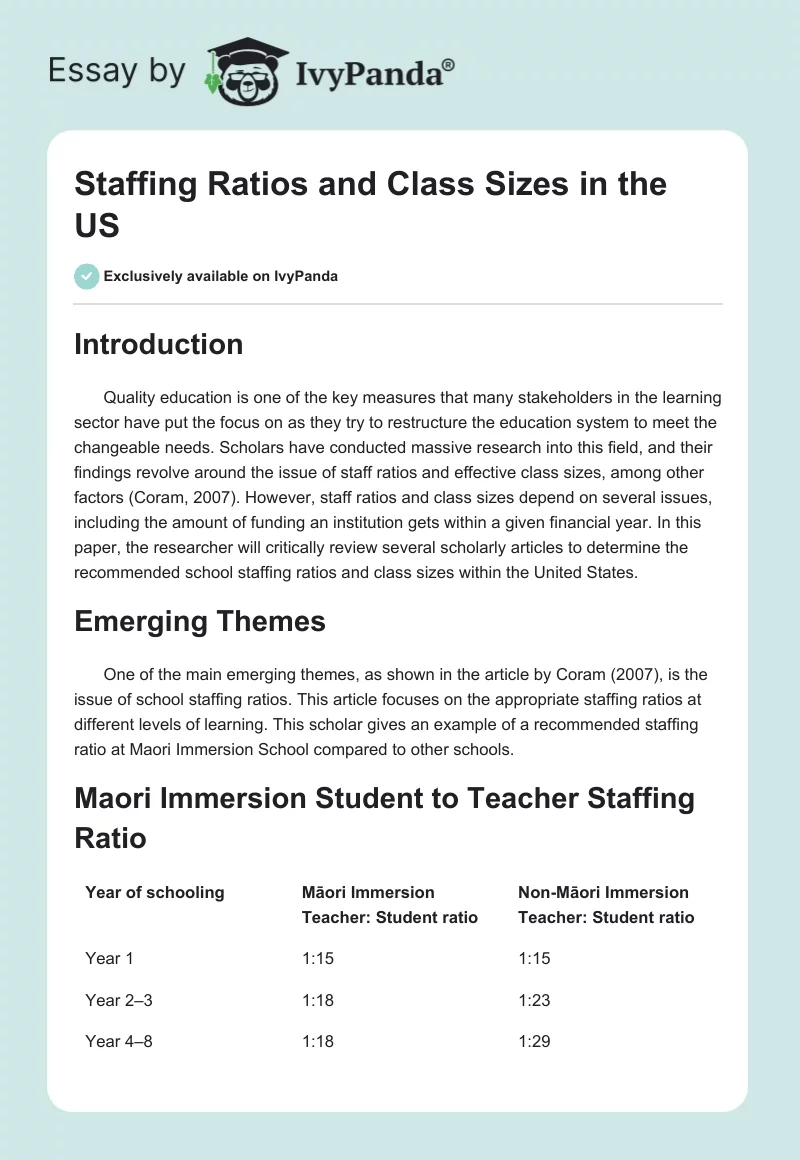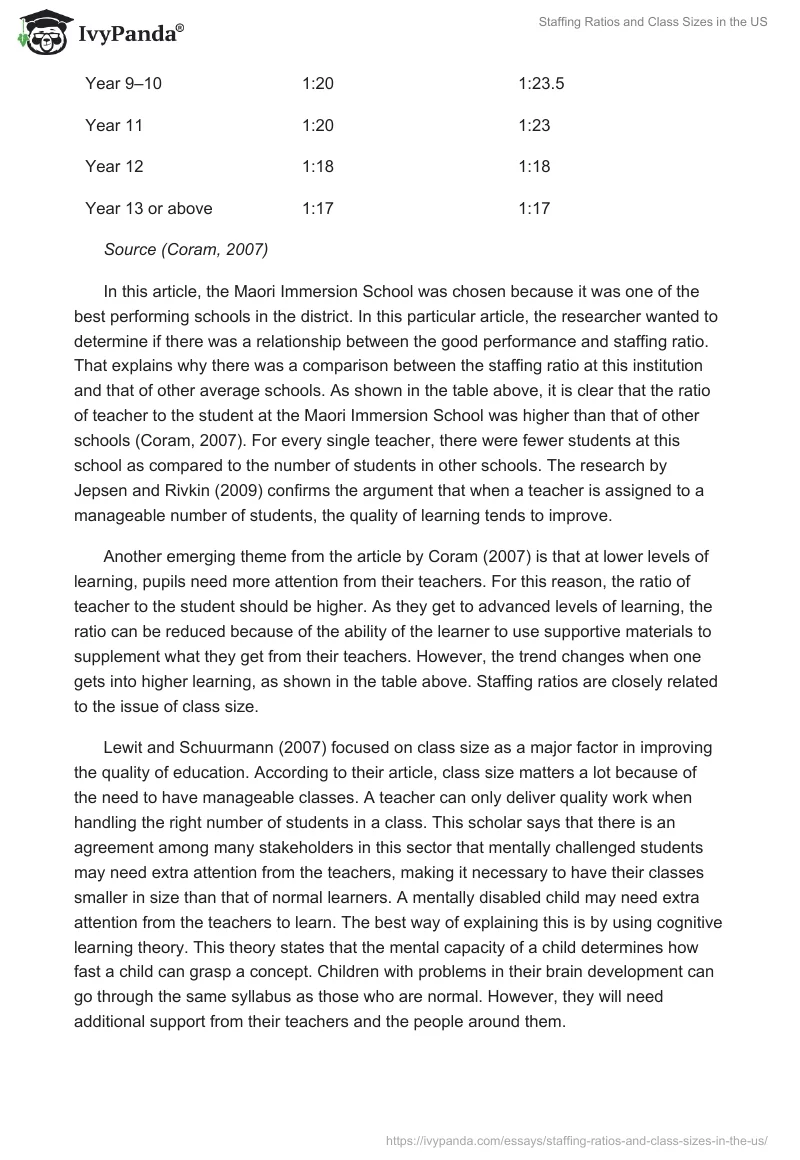Introduction
Quality education is one of the key measures that many stakeholders in the learning sector have put the focus on as they try to restructure the education system to meet the changeable needs. Scholars have conducted massive research into this field, and their findings revolve around the issue of staff ratios and effective class sizes, among other factors (Coram, 2007). However, staff ratios and class sizes depend on several issues, including the amount of funding an institution gets within a given financial year. In this paper, the researcher will critically review several scholarly articles to determine the recommended school staffing ratios and class sizes within the United States.
Emerging Themes
One of the main emerging themes, as shown in the article by Coram (2007), is the issue of school staffing ratios. This article focuses on the appropriate staffing ratios at different levels of learning. This scholar gives an example of a recommended staffing ratio at Maori Immersion School compared to other schools.
Maori Immersion Student to Teacher Staffing Ratio
Source (Coram, 2007)
In this article, the Maori Immersion School was chosen because it was one of the best performing schools in the district. In this particular article, the researcher wanted to determine if there was a relationship between the good performance and staffing ratio. That explains why there was a comparison between the staffing ratio at this institution and that of other average schools. As shown in the table above, it is clear that the ratio of teacher to the student at the Maori Immersion School was higher than that of other schools (Coram, 2007). For every single teacher, there were fewer students at this school as compared to the number of students in other schools. The research by Jepsen and Rivkin (2009) confirms the argument that when a teacher is assigned to a manageable number of students, the quality of learning tends to improve.
Another emerging theme from the article by Coram (2007) is that at lower levels of learning, pupils need more attention from their teachers. For this reason, the ratio of teacher to the student should be higher. As they get to advanced levels of learning, the ratio can be reduced because of the ability of the learner to use supportive materials to supplement what they get from their teachers. However, the trend changes when one gets into higher learning, as shown in the table above. Staffing ratios are closely related to the issue of class size.
Lewit and Schuurmann (2007) focused on class size as a major factor in improving the quality of education. According to their article, class size matters a lot because of the need to have manageable classes. A teacher can only deliver quality work when handling the right number of students in a class. This scholar says that there is an agreement among many stakeholders in this sector that mentally challenged students may need extra attention from the teachers, making it necessary to have their classes smaller in size than that of normal learners. A mentally disabled child may need extra attention from the teachers to learn. The best way of explaining this is by using cognitive learning theory. This theory states that the mental capacity of a child determines how fast a child can grasp a concept. Children with problems in their brain development can go through the same syllabus as those who are normal. However, they will need additional support from their teachers and the people around them.
The article by Kieron (2004) identifies the role and size of the support staff as another major theme that should not be ignored in a learning system. The support staff, such as the custodial, security officers, and food service employees, play an important role in the learning setting. According to Gorski (2013), previous studies have ignored the relevance of having the right ratio of students to support staff to have a good learning environment. This scholar admits that it is not yet clear how this ratio should be because a few scholars who have focused on this area of study keep giving contradictory results. Milesi and Gamoran (2008) note that hiring of the support staff should be done in a clear pattern based on their needs within a learning institution. There seems to be an agreement on the fact that the number of support staff should be proportionate to the number of learners. For instance, there should be enough librarians to attend to the needs of the learners whenever they visit the library. This way, time will not be wasted when learners visit the library. Similarly, security officers should be able to meet the needs of the learners without any disappointments.
Emerging Trends
It is important to analyze some of the emerging trends in staffing ratios and effective class sizes in various states within this country. According to Dee and West (2011), in the United States, each state is responsible for educational policies that define issues such as class size and staffing ratios. In many states, the emerging policies base the ratio on the availability of funding. Cases, where institutions trim their staff when they are financially constrained, are common in many states within this country. Wilson (2009) says, “When it comes to saving money, universities are laying off staff members, freezing future faculty hiring, imposing furloughs, and trimming operating expenses” (p. 1). Although it is undesirable to lay off staff, this scholar says that sometimes these institutions are left with no options but to lay off their staff.
In many institutions, there is an emerging trend where administrations try to hide the truth about the financial position of their organizations when experiencing financial challenges. Chabotar (2009) says, “During a period of financial difficulty, presidents and chief financial officers can be tempted to restrict the flow of information and to discuss financial exigencies only with senior staff members” (p. 1). The scholar further explains that this is always done to avoid possible cases of panic. As the management tries to find possible solutions to the problem, the employees should not develop fear because this may have a serious effect on the normal operations of the institution.
Impact on Student Learning
The issue of class size and staffing ratios has a major impact on student learning. This means that the staffing ratios should not just focus on teachers but also other important staff within a school. Having an effective class size does not necessarily mean having very small class sizes. It means having the right size that will allow for close interaction between the learner and their teacher. It is important to have a class size that will allow the teacher to understand the capacity and needs of individual students within the class. According to Giorgi, Woolston, and Pellizzari (2012), recent studies have confirmed that having a small class size makes it possible to have a better teacher-student interaction. With the right class size, one of the most important impacts is that a teacher will be able to attend to the needs of the students without straining. This will enhance the student’s learning. Having the right class size also has an impact on the ability of the learners to engage in group discussions, especially among the advanced learners. With about 24 learners in a class, these advanced level students can form six discussion groups that can engage in healthy competitions, as they try to advance what they get from their teachers.
Conclusion
It is clear from the discussion above that having an effective class size plays an important role in enhancing the quality of education in schools. Different levels of learning have different requirements in terms of the student to teacher ratio. At lower levels of learning such as kindergarten, 1st, and 2nd grades, this ratio should be lower. On the other hand, learners at higher levels, such as K-12, may need a slightly higher ratio not only for their academics but also for social development. It is important to note that funding that is available for a given school will have direct impacts on this ratio.
Recommendations
The discussion above shows that school staffing ratios and class sizes matter a lot when determining the quality of the learning environment. It would be important for policymakers to observe the following recommendations.
- The state government should set and find effective ways of enforcing program standards.
- The government should provide resources to meet the set program standards in all schools.
- The government should support further research on the issue of class sizes.
References
Chabotar, K. J. (2009). How to communicate in a difficulty economy. The Chronicle of Higher Education, 55(23), 1.
Coram, T. (2007). Research on Ratios, Group Size and Staff Qualifications and Training in Early Years and Childcare Settings. Research Report 489(7), 1- 236.
Dee, T. & West, M. (2011). The Non-Cognitive Returns to Class Size. Educational Evaluation and Policy Analysis, 33(1), 23-46.
Giorgi, G., Woolston, W. & Pellizzari, M. (2012). Class Size and Class Heterogeneity. Journal of the European Economic Association 10(4), 795-830.
Gorski, P. (2013). Building a pedagogy of engagement for students in poverty. Journal of Educational Studies, 95(1), 48-52.
Jepsen, C. & Rivkin, S. (2009). Class Size Reduction and Student Achievement: The Potential Tradeoff between Teacher Quality and Class Size. The Journal of Human Resources 44(1), 223-250.
Kieron, B. (2004).Staffing the Secondary School. Oxford Review of Education, 11(1), 19-31.
Lewit, E. & Schuurmann, B. (2007). Class Size: The Future of Children. Financing Schools, 7(4), 112-121.
Milesi, C. & Gamoran, A. (2008). Effects of Class Size and Instruction on Kindergarten Achievement. Educational Evaluation and Policy Analysis 28(4), 287-313
Wilson, R. (2009). In hard times, colleges search for ways to trim faculty. The Chronicle of Higher Education, 55(40), 1.


